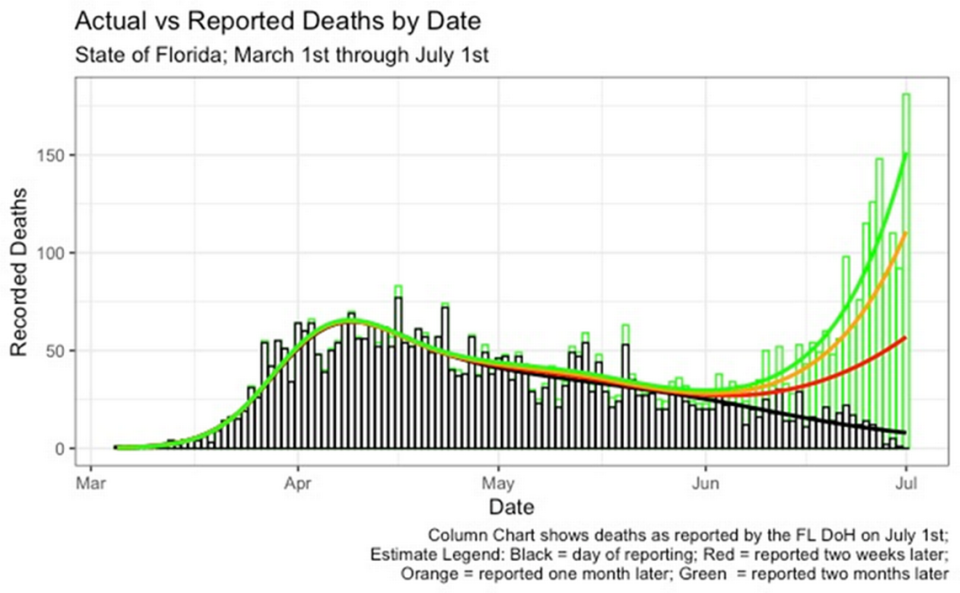COVID-19 could be the leading cause of death in Miami-Dade County by the year’s end
The death toll from Miami-Dade County’s summer COVID-19 resurgence is still being counted, even though the disease peaked about two months ago. Public health experts attribute the backlog to a lengthy reporting process and the sheer number of people who passed away in Florida’s virus hot spot.
The Florida Department of Health, which continues to register COVID-19 deaths from July, told the Miami Herald on Thursday that it announces deaths as they are reported to the agency, but did not elaborate on why deaths were taking so long to be reported. The death toll for Miami-Dade hit 3,027 on Friday, accounting for about 23% of Florida’s 13,225 COVID-19 deaths.
About a month ago, medical examiners warned of a backlog of more than 650 deaths in Miami-Dade County and more than 1,200 across the state. As a result, the Florida Medical Examiners Commission voted to streamline the process by allowing physicians to certify COVID-19 deaths without medical examiners signing off.
The extent of the backlog is no longer clear because medical examiners are no longer certifying every COVID-19 death, but local public health professors are finding that the deaths typically lag five or more weeks behind.
“We have not seen the extent of how bad the summer was,” said Mary Jo Trepka, an epidemiologist and professor at Florida International University’s Robert Stempel College of Public Health & Social Work, earlier this week.
Trepka said that the backlog from deaths that occurred in July and August has pushed the mortality rate beyond 100 deaths per 100,000 people in the county — a level comparable with cancer and heart disease, the two leading causes of death in Miami-Dade.
“That’s where we are right now,” Trepka said. “[COVID-19] dwarfs all other causes of death if we compare it to 2019, because we’ve only had half a year [of COVID-19 deaths.]”
Gabriel Odom, a biostatistics professor at FIU’s Stempel school who has been working with COVID-19 death data for local officials, said about 107 people have died from the disease for every 100,000 people in Miami-Dade County, a rate he calculated this week. And he reiterated Trepka’s point that COVID-19 might end up causing more deaths than any other disease this year — not just in Miami-Dade County but in the entire state.
“It may actually unseat heart disease for the state of Florida by the time this year is over,” Odom said.
In 2019, about 5,112 people in Miami-Dade died from heart disease, a rate of 136 per 100,000 people, according to the Florida Department of Health, making it the leading cause of death in the county, ahead of cancer, which killed 4,320 people last year, at a rate of 119 per 100,000 people.
The true extent of the deadliness of COVID in a given week in Miami-Dade isn’t known until five or more weeks later, Odom has found, based on when the deaths are reported versus when they actually occurred.
Odom calculates the delay in death reporting by charting the deaths reported by the health department on a given day and matching them to the days they actually occurred.

Odom said it was important to show that difference to local officials and the public so that people could better understand the true extent of the virus’ toll on the community and the risk associated with spreading it.
“Human beings struggle with understanding probability and risk,” he said.
Almost every day, Odom said he looks at COVID-19 deaths and imagines the lives of the people who passed away — someone’s grandmother, someone’s aunt, who will not be experiencing Thanksgiving with their families this year.
“People need to realize this thing is real, and it is deadly,” he said. “Even if you’re young, and you’re under 50 years old ... even if you could shake it off like a little bit of a cold, you could pass it on to someone and it would kill them.”

